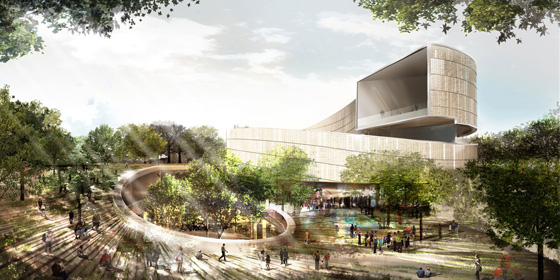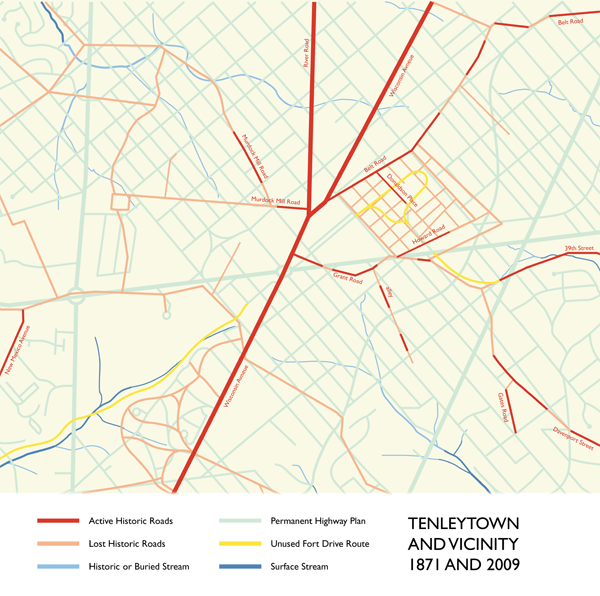- Enasculin Ensaculin: Treats dementia by demolishing your ego!
- Lord Adonis: Not a 19th-century dandy, just of Greek heritage.
- Paedocommunion: Involves priests. Plus, “pedo” with a dipthong just sounds like molestation.
- Republican Marriage: Not the opposite of same-sex marriage. In fact, some would say that all marriages have a similar effect.
- Lesbian Wine: Not actually produced at Larry Flynt’s ancestral grange in Broussy-le-Petit, but rather on the island of Lesbos.
- Anal Language: “Not to be confused with the Anus Language”
- Boring Lava Field: But only compared to Mount Ranier.
At the end of the Mall, hope.
The six finalists for the design of the National Museum of African-American History and Culture have been revealed, with some very promising and also very disappointing results. There’s not nearly enough information available to see which is really the best building, so I picked the one that I think can be improved upon in a productive way. Remember as you are reading my thoughts that these are in the conceptual design phase, so the architects will be revising the buildings considerably even before the NCPC and CFA get around to prodding the architect for greater contextuality.
I’ve ranked these in ascending order of quality and appropriateness and then got my buddy Sam Rothstein to handicap each one’s chance at selection. The images are linked to high-res versions on the Smithsonian site.
nm0000001? Never heard of him.
Curio facts though these may be, it does make some interesting insights into the origins of IMDb on usenet.
DC’s Shovel-Ready Projects
Colorado gets transparency better
 It’s still a lot of semi-imaginary cash thrown at highway construction, which isn’t a good long term allocation for several reasons, but at least they tell us where it’s going with maps…
It’s still a lot of semi-imaginary cash thrown at highway construction, which isn’t a good long term allocation for several reasons, but at least they tell us where it’s going with maps…
This may be the worst graph ever…

From the Delaware Recovery Site. There’s neither a scale nor any quanta, it’s made of shapes that distort the sizes, it has a dull gray background, the labels are unexplained and uncomfortably juxtaposed, and it sure takes a lot of space to say absolutely nothing here… Edward Tufte is probably having a conniption. This kind of graphical blather is no way to further government transparency and demonstrates plain incompetence on the part of the PR department.
Why Design Matters for the Stimulus: The Government
In choosing to spend so much money to build new infrastructure, Congress and the President have committed to constructing utilities and transportation for the next fifty years. Consequently, all of these structures and systems must reflect this long-term goal, not only in the quality of construction but also in the quality of design. As they allocate the federal funding, governments and agencies should consider the very real need for public projects to employ an architecture of civic responsibility. Architects, in turn, should be ready to adapt their practices to meet the need for basic public design, a major shift many are eager to try.
First off, it’s worth explaining what the stimulus bill offers architects and agencies? There are two major categories: firstly, sustainable or “green” renovations and expansions of housing, schools, and government offices, and secondly, the money granted to local utilities chance to be creative with unconventional programs and types with a thin budget. The former type of project is not too different from what they’d be doing most days, although those firms would benefit greatly from improving technological capabilities, such as employing building information modeling, which reduces cost and improves quality by reducing errors, simplifying design, and allowing for sophisticated environmental testing. The government should encourage the use of these programs, setting a standard for 21st-century architecture and construction.

In the second category, there are many types of buildings that have been neglected aesthetically or financially that are now receiving large grants as part of the stimulus. Transportation, power plants and electrical systems, water treatment facilities, housing projects, and port facilities will all be receiving funding for improvements. The government owes it to the people who live by, pass through, or otherwise see the underside of public infrastructure to improve quality. More attractive overpasses, wind farms, and customs houses will make a small but important improvement of the built environment, definitely impacting the daily lives of Americans.
Similarly, funding for transit organizations can go to better bus shelters or bike stands. As the recent competition in New York showed, small firms are ready to make simple but interesting designs for little bits and pieces on the street. Both proponents and opponents of spending are fixated on monumental projects, things that will last. However, wide projects of small improvements might make just as much of an economic and physical improvement. Planting thousands of trees would pay off far more than another highway resurfacing, especially as part of a greater streetscape improvement plan. Moreover, agencies should set aside a small portion of their funds to ensure that a little art and a little design make it into every project, improving the quality and distinctiveness of each and every location. Many of these facilites are in people’s backyards; planners need to respect the neighbors.
A notable exception to the recent pattern of charmless public architecture is the Newtown Creek Wastewater Treatment Plant, in Queens. Designed by the ever-pragmatic and flexible Polshek Partnership Architects of Newseum fame, the multi-million dollar project has met with universal praise and become an icon of the area, while still efficiently treating blackwater sewage. Polshek designed it with a modern industrial look, simplifying and beautifying the fascinating shapes of anaerobic digesters and aeration buildings. Additionally, the building is designed for tours and educational visits, while a 1% allotment for art has allowed for bold lighting that stands in contrast to the dull orange glow of the city.
Through all the praise for both the Newtown Creek plant, critics and officials have emphasized how different they look from conventional buildings and how much more attractively these massive plants interact with the rest of the neighborhood. People are surprised that the buildings aren’t ugly, as though this is an innovation that took a genius. However, architects have historically approached such facilities as civic assets, building them out in a monumental fashion. Likewise, the New Deal introduced art and architecture to almost every project it executed, from libraries to TVA dams. These buildings reflected the cultures and programs of their builders. It would reflect poorly on our time if we settle for bare function and apathy.
Government’s role in improving and stewarding common places means that it must provide and demand attractive, functional facilities for its people. For this reason, renewing America means not only fixing it up at basic levels, but also making it more beautiful at the same time. Architects are ready and eager to improve the country, but they will have to adapt to new conditions. Indeed, they may be better for it if they grow creatively in response to limitations and employ technology in making practice faster and more transparent. But they have to get the work. If agencies set aside only a small portion of funds for architecture, lay out the goals, pick like-minded architects, and insist on good results, the resulting cultural effusion would boost the resolve of Americans and leave a long-lasting improvements in the most desperately needed places.
In Part Two, some thoughts on how architects should approach Stimulus design.
“Anything except titanium skewers”
You might also want to check out his film productions at Cocaine in Motion, particularly their Sand Moon movie (not really funny). They also have some amazing parables on Youtube. They feature the Methodist Cemetery and Fort Reno in a number of flicks.
Turn off the sound and just watch the hands.
Streets through time and place
 I noticed yesterday that DC has re-signed Murdock Mill Road, down off River Road in Tenleytown. It’s a nice little reminder of history – and of natural geography – among the rationalist streets of the city plan laid down in 1897. While those straight, predictable lines make navigating the city easy, they did erase the context and history of what was Washington County. By its perseverance, this little snippet of prior use reminds residents of the pre-urban past, adding quiet character to the neighborhood.
I noticed yesterday that DC has re-signed Murdock Mill Road, down off River Road in Tenleytown. It’s a nice little reminder of history – and of natural geography – among the rationalist streets of the city plan laid down in 1897. While those straight, predictable lines make navigating the city easy, they did erase the context and history of what was Washington County. By its perseverance, this little snippet of prior use reminds residents of the pre-urban past, adding quiet character to the neighborhood.
The road itself is no larger than an alley – its form preexists both the automobile age and the dreams of a residential garden city, so there are neither sidewalks nor setbacks. It is discontinuous, with one part behind the old Sears Building and the other appearing a few blocks to the west before becoming Butterworth Street. It’s also completely secondary: Where the narrow eastern section intersects with 42nd Street, the heavy grading on the latter route necessitates a concrete retaining wall and a stairway down from Murdock Mill Road, ten feet above. It is very dislocated; left inexplicably during the changes of urbanization, along with the Methodist Cemetery, its only active address.
The road once headed down in the direction of Massachusetts Avenue, following a creek of the same name. Before the imposition of the 1897 Permanent Highway Plan, Murdock Mill Creek began at the west of Tenleytown, and cut through a subdivision of small farms registered as part of Friendship, and finally into what is now the Dalecarlia reservoir. Now, the stream is undergrounded, emerging only from underneath 52nd Place in northern Spring Valley. Other streams have been buried; still more roads have disappeared when developers carved up the farms they existed to serve. Murdock Mill Road is only one of these many streets, some of which are still used.


